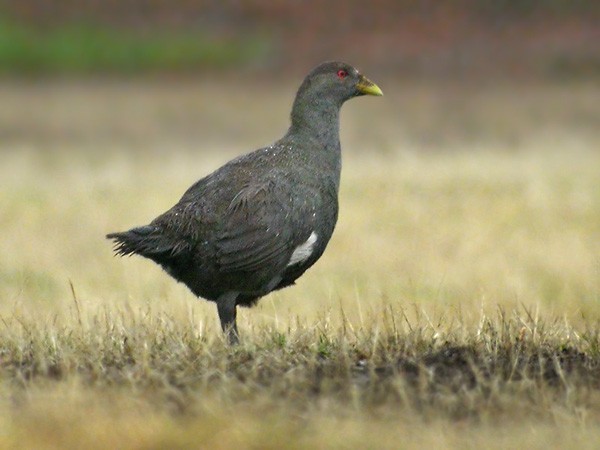Tasmanian Nativehen
A species of Moorhens Scientific name : Tribonyx mortierii Genus : Moorhens
Tasmanian Nativehen, A species of Moorhens
Botanical name: Tribonyx mortierii
Genus: Moorhens
Content
Description General Info
 Photo By Lars Petersson
Photo By Lars Petersson Description
The Tasmanian native hen is a stocky flightless bird between 43 and 51 centimetres (17 and 20 in) in length. The upperparts are olive brown with a white patch on the flank. The underparts are darker with a bluish grey tinge. The short tail is close to black and mostly held erect. The legs are thick and powerful, with a grey scaly appearance and sharp claws. The eyes are bright red. The bill has a small frontal shield and is a greenish yellow colour. The juvenile bird is similar in appearance to the adult, but the colours are more subdued on the body and the underparts have fine white spots. The bill is greenish yellow and the eyes are bright red. Male birds generally have longer bills and legs, though there is enough overlap that the sexes are indistinguishable, even in the hand. 
Size
51 cm
Nest Placement
Ground
Feeding Habits
Tasmanian Nativehen primarily grazes on grass shoots and low herb leaves during daylight hours, supplementing with insects, seeds, and fruit. This secondary grazer benefits from cleared grasslands, originally due to indigenous burning practices, now also due to agricultural expansion and rabbit activities.
Habitat
The tasmanian Nativehen predominantly occupies habitats around permanent or seasonal freshwater wetlands such as marshes, lakes, and rivers, often in proximity to open pastures, grasslands, and agricultural lands with cleared vegetation. The presence of dense cover like reeds, rushes, or willows is crucial for shelter and nesting. Although generally avoiding saline wetlands, the tasmanian Nativehen frequents areas with abundant freshwater resources and requires short-grazed vegetation for foraging, often maintained by grazing animals.
Dite type
Omnivorous
General Info
Feeding Habits
Bird food type
Behavior
The Tasmanian native hen's social organisation has been extensively studied. Tasmanian native hens live in groups of between two and five, plus the young birds from the previous breeding season, which tend to stay with the group and contribute to the care of the young until they move off to establish their own territories after approximately one year. The sedentary nature of the species means that groups hold sharply defined territories of up to 5 acres (2.0 ha), and repel transgression into their territory vigorously with calls and displays. Fights can also occur, where birds will jump, peck and kick at each other violently, sometimes drawing blood and pulling feathers. The breeding structure may be monogamous or polygamous, usually polyandrous. Each group contains a single breeding female who will mate with all the males of the group. The unusual social structure based on groups who stay together is not known to occur in many other species; the high ratio of male chicks to female chicks hatched is thought to be a possible explanation for this. The Tasmanian native hen has 14 separate calls, ranging from low grunts to high pitched alarm calls as well as a see-sawing duet performed in unison, rising to a crescendo of harsh screeching notes, It also calls at night. Although flightless, this bird is capable of running quickly and has been recorded running at speeds up to 48 kilometres per hour (30 mph). It uses its wings when running fast to help it to balance. 
Distribution Area
The Tasmanian native hen is a sedentary species, living around open grassy areas close to water. It is widespread in Tasmania apart from the west and south west regions. It is not found on King or Flinders Islands in Bass Strait, though Michael Sharland does record it as being on Flinders Island. A population introduced to Maria Island is now well established. It is generally common and easily seen around bodies of water that have grassy verges. Fossil records indicate that the Tasmanian native hen was found on the Australian mainland until around 4700 years ago. Suggested reasons for its extinction there have included the introduction of the dingo, or an extremely dry period. 
Species Status
The Tasmanian native hen is currently classified as a species of least concern by the IUCN. Although there is a healthy population size and no significant falls have been measured, there is concern about the possible arrival of the red fox in Tasmania and the possible impact that it will have on this and other species. As of 15 August 2007, the Tasmanian native hen was listed as protected under Tasmanian legislation. Prior to this the Tasmanian native hen was one of only four native birds that had no legal protection outside national parks and other reserves in the state of Tasmania—the last of Tasmania's 12 endemic bird species with this dubious status. The three remaining unprotected native species are the forest raven, the great cormorant, and the little pied cormorant. All other native Tasmanian birds are listed as protected under the state's Nature Conservation Act 2002. 

 Photo By Lars Petersson
Photo By Lars Petersson